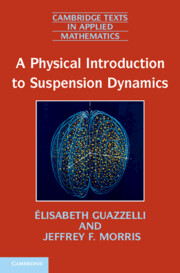6 - Sedimentation
Published online by Cambridge University Press: 05 June 2012
Summary
The sedimentation of particles is one of the basic flows involving suspensions. It is also one of the oldest known separation techniques, e.g. to clarify liquids (or alternatively to recover particles) or to separate particles of different densities or sizes. Sedimentation is also ubiquitous in natural phenomena such as the fall of rain drops and dust particles in the atmosphere, or mud sedimentation in rivers or in estuaries. In this chapter, we focus our attention primarily on the sedimentation of small solid spheres of equal size and density for which the Reynolds number is small. We will, however, also take a brief glance at particles having different size, density, and shape at the end of the chapter. The long-range and many-body nature of the hydrodynamic interactions between the particles that we have introduced in Part I is the key feature in describing a number of interesting and unexpected phenomena in sedimentation. These interactions give rise to complex and collective dynamics which are not completely understood and remain the subject of active research. This chapter is based on the reviews of Davis and Acrivos (1985) and Guazzelli and Hinch (2011), where the reader can find further information.
One, two, three … spheres
When a sphere of radius a and density ρp settles in a quiescent viscous fluid, it generates a disturbance flow which decays very slowly away from the translating particle, i.e. as the inverse of the distance to the sphere for the dominant portion, as shown in Chapters 2 and 3.
- Type
- Chapter
- Information
- A Physical Introduction to Suspension Dynamics , pp. 127 - 154Publisher: Cambridge University PressPrint publication year: 2011

